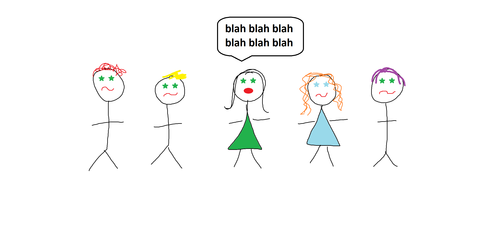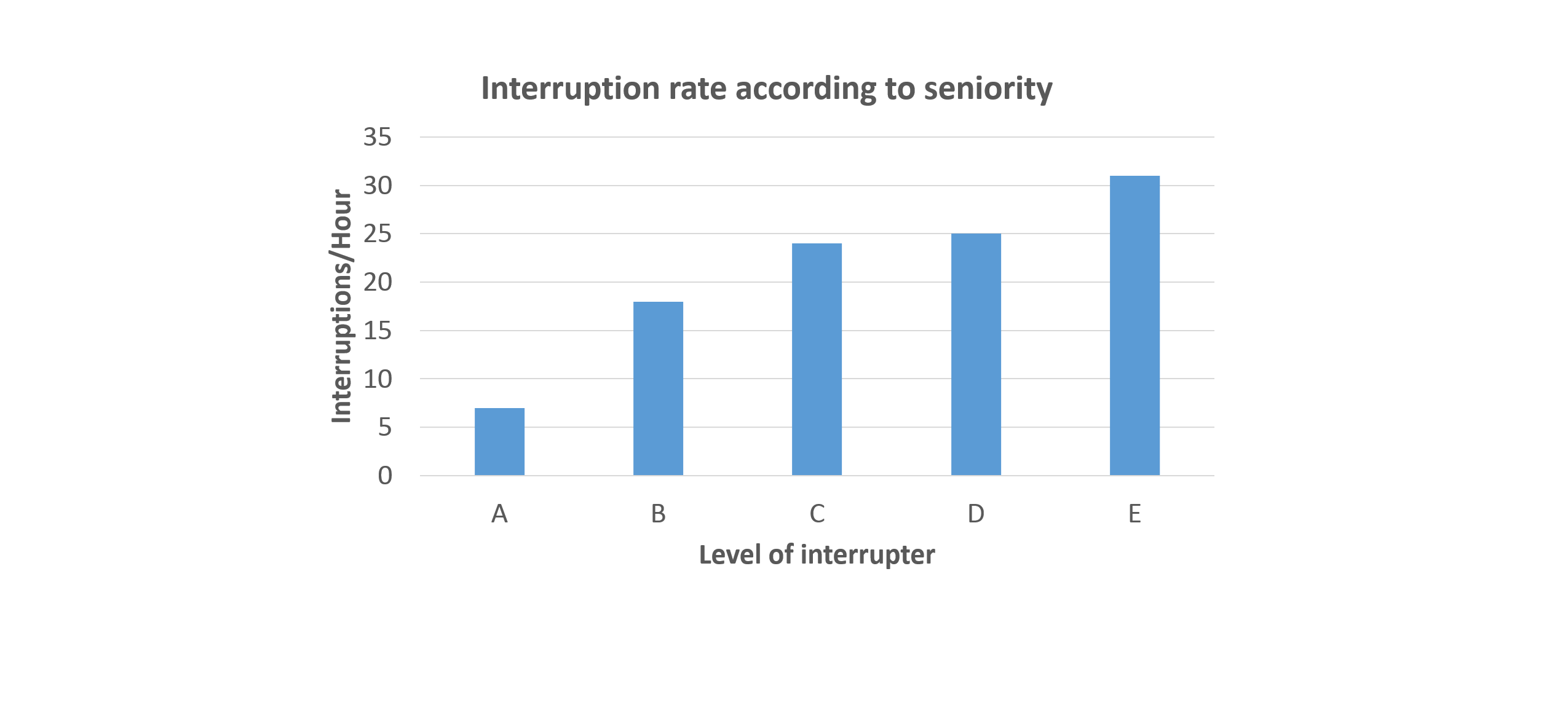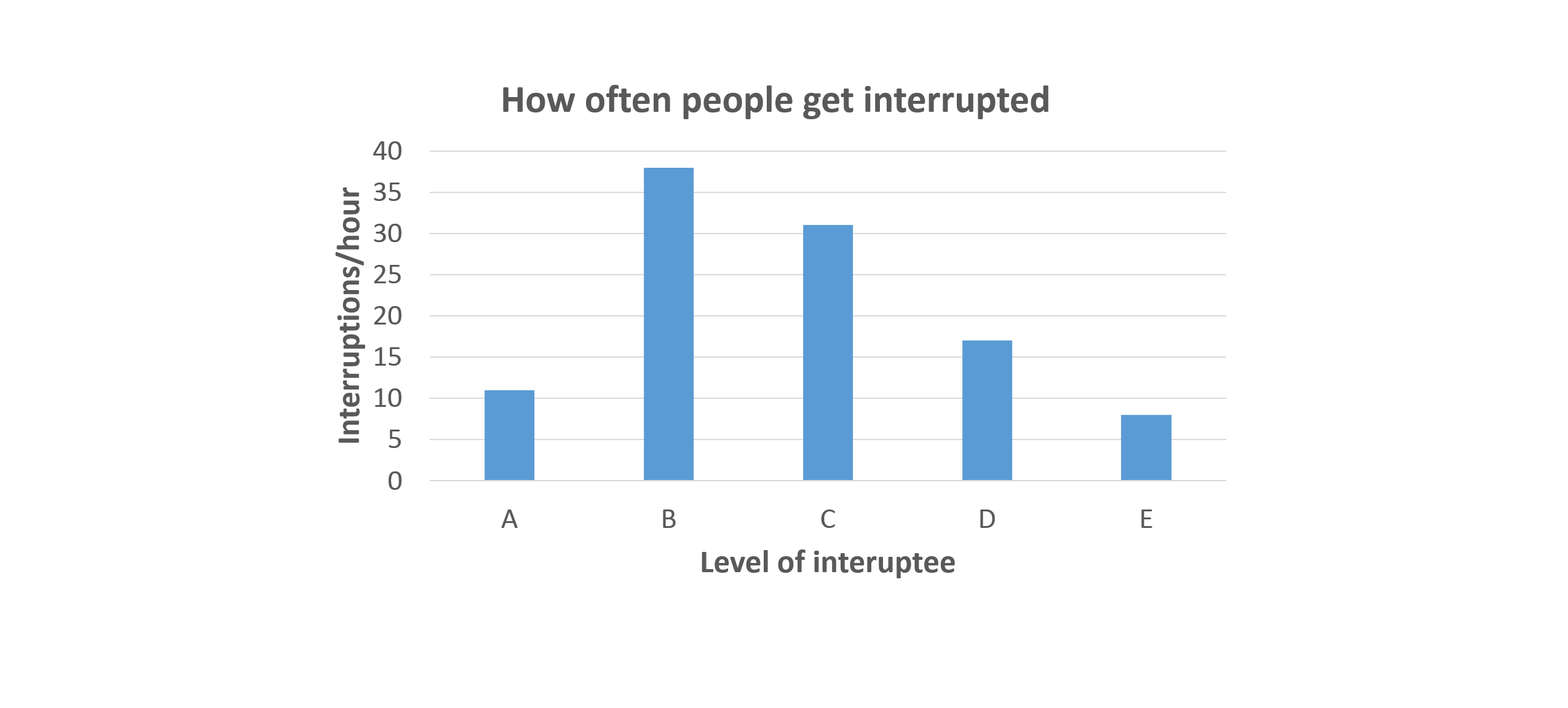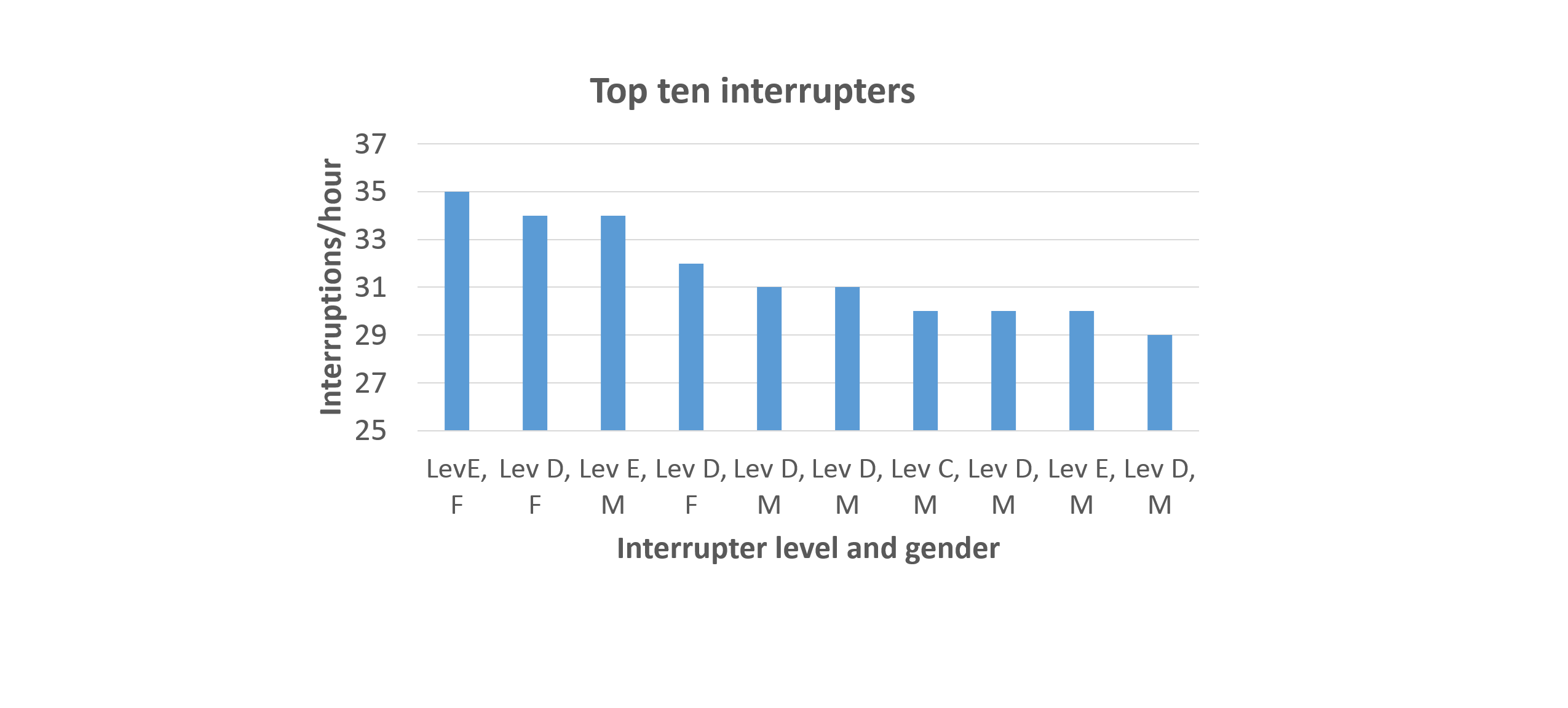Want to get ahead as a woman in tech?
Learn to interrupt.
« previous post | next post »
Below is a guest post by Kieran Snyder.

This week’s earlier posting on interruptions, in which I presented data to suggest that men interrupt more than women in the tech workplace, and that women are interrupted all the time by everyone, has easily been the most viewed, discussed, tweeted, and shared jenga post so far. This is due in no small part to the cross-posting picked up by Language Log, so many thanks to Mark Liberman for sharing it and to my linguist friends who suggested it. You can take the girl out of linguistics, but it’s hard to take linguistics out of the girl.
In case you missed the first post, a quick recap. In this totally observational and directional study, separate from any other factors, men interrupt women about three times as often as they interrupt other men. In a climate where interruptions happen on average once every two minutes and fifty-one seconds, there is less than one instance per hour of a woman interrupting a man for any reason. You get the idea: big tech is not an equitable environment as far as interruptions are concerned. This makes sense, since it is not a particularly equitable environment in terms of hiring and promotions either.
I wondered in conclusion how things would play out differently in single-sex environments, or in coed environments with many more women than men. I’ve also started tracking a parallel observational study based on how my four-year-old daughter and her friends interact, which I will report on as soon as I have enough data for it to be meaningful.
Commenters raised several excellent follow-up questions in addition to those that I posed in the original article. How much does the formal nature of the corporate setting change the overall interruption rate? Do we see different patterns for supportive interruptions (e.g. clarifying questions, statements of agreement and affirmation) and intrusive interruptions (e.g. conversational hijacks, direct disagreement and confrontation)? What is the average time to interrupt? In other words, how long are men and women respectively able to hold the floor before they are interrupted, and how long do men and women respectively yield the floor to the active speaker before initiating an interruption? These are all terrific questions that I do not right now have data for.
One question that came up a lot that I do have data for, however, is how significant professional seniority is as a variable. Because I tracked individual interrupter and interruptee speaker IDs for every interruption event that I recorded, and because I know all the people in all the conversations, I can look at a few other factors in addition to gender. In particular, because everyone in all the conversations works at the same company, I know everyone’s specific professional level within the shared organization. In this post I’ll go into the effect of professional seniority.
Here’s what I found.
The more senior the speaker, the more they interrupt.
This won’t surprise many readers, since several commenters posited that we would see a strong correlation between professional level and willingness to interrupt a colleague. The graph below illustrates interruption rate across professional levels for the 314 total interruptions that I logged. On the x-axis, A represents the most junior level and E the most senior. The speaker population is not distributed evenly across levels, with by far higher concentrations of speakers in levels B, C, and D. The y-axis representations interruption rate in terms of average interruptions/hour (rather than sheer number of total interruptions) as a means of normalizing for the uneven population distribution across levels. Recall that the rate across all speakers is close to 21 interruptions/hour.
As expected, more senior speakers have higher average interruptions/hour than more junior speakers.
The more junior the speaker, the more likely they are to get interrupted. Mostly.
This is where I regret that I logged only interruptions and not overall speaking events, and also where I’m feeling like the next corporate meeting study someone does needs to use a recorded corpus. When I started on this path, I was mostly just curious what I would see and didn’t know that I would find anything worth sharing. Oh well.
The table below makes it look like entry/mid-level (Level B) people get interrupted the most often, and while that is true in terms of sheer number of total interruptions, it doesn’t tell the whole story. Of the 314 interruptions I logged, the plurality of them are interruptions of Level B speakers. However, since I only logged interruptions and not overall speaking turns, the numbers I have don’t show what proportion of the time that Level As speak that they get interrupted. The reality is that Level As aren’t speaking very much at all in these meetings to begin with, so they don’t have the opportunity to get interrupted very much. Unfortunately, we’ll have to prove that with data in another study.
Just as above, the figure below captures interruption rate in terms of average interruptions/hour.
There are no senior women who aren’t interrupting their male colleagues.
I mean literally there are none. Not one. Nada.
This one is a big deal so let’s dive into it. There were very few women overall in Levels D and E; I am in those levels, but we can’t count me since I didn’t attempt to log my own interruptions. That leaves three women remaining that I observed in those levels as compared to twelve men, which is not surprising but which starts to make me feel strange about this study in a number of respects.
Recall from the last post that only 13 of the 314 total interruptions logged across 15 hours of speech were instances of women interrupting men. So wait for it – all 13 of those instances came from this set of three women. Probably not too surprising since we’ve just looked at data showing that senior people are the most likely to interrupt.
But it goes further: Not only do these three women interrupt everyone, gender- and level-agnostic, they represent three of the four biggest interrupters in the study. Their rates of interruption/hour are, respectively, 35, 34, and 32, with one male colleague in Level E coming in at 34 and literally everyone else in every level showing a lower rate. What’s more, the next closest woman in the study, a Level B with an interruption rate of 27 interruptions/hour, trails far behind.
Here’s how the top ten interrupters break down in terms of level/gender identity and their interruptions/hour rate:
The results suggest that women don’t advance in their careers beyond a certain point without learning to interrupt, at least in this male-dominated tech setting. This is really striking, and starts to put directional data behind the stereotype whereby strong female leaders are often dismissed with the pejoratives bossy, unpleasant, and bitchy. As a senior woman in technology who has at times been called all of those things, I’d like to say I’m surprised. I’m not.
There is a vital study that someone ought to do that dives into this more deeply. My observational study includes under 100 speakers, and it relies on my judgment (and only my judgment) to discern interruption events. Even just in this corporate tech setting, more rigor is needed to feel confident of the bold directional claims I present here.
But I’ll tell you this: Not a single woman in technology (of any level) that I know is surprised by these results. While the academic linguistic community has appropriately responded with suggestions for follow-ups and rigorous methodology, women in tech have mostly responded, “Yeah, duh.”
Above is a guest post by Kieran Snyder.



D.O. said,
July 17, 2014 @ 12:56 pm
Just for the sake of symmetry, how often these senior women were interrupted compared to senior men. I understand that it was rare for all senior people, but still worth looking.
B. said,
July 17, 2014 @ 1:04 pm
"The results suggest that women don’t advance in their careers beyond a certain point without learning to interrupt, at least in this male-dominated tech setting. "
Unless I'm missing something, the results do not suggest that "learning to interrupt" is a prerequisite for advancement, which is what this sentence strongly implies. The results just as plausibly suggest that those who have advanced, interrupt.
J. W. Brewer said,
July 17, 2014 @ 1:09 pm
What would be interesting (but now probably inaccessible other than in a very impressionistic/anecdotal way — and I want to be careful not to criticize this interesting data for not being something it isn't and that it couldn't be without lots more resources and time) is the prior history of the now-senior people with respect to this behavior. That senior people generally interrupt more does not tell you whether a junior person who interrupts more than is common for people at that level is helping or hurting his or her (and the answer might vary by sex) chances of promotion. One could tell a plausible just-so story that people who adopt the affect of a more senior role than they in fact currently hold thereby lead other people to see how good a fit they are for that role (improving their chances of promotion), and one could tell an equally plausible story that people who do not conform their behavior to that deemed contextually appropriate for their current role will rub people the wrong way (and/or more specifically lead people to conclude that they're arrogant and/or bad at understanding social cues), thus undermining their chances for promotion.
Coby Lubliner said,
July 17, 2014 @ 1:20 pm
Is there any connection between interruption and the heavily touted "disruption"?
Sam C said,
July 17, 2014 @ 1:47 pm
Three women all working for the same company, possibly in the same department, doesn't sound like a great sample size to me, but I'm really interested in the results you got nonetheless. And completely unsurprised by the proportion of interruptions by seniority level. And while it's a leap, I feel secure saying that if more women had more senior positions in tech, we'd see more women interrupting people in meetings.
cs said,
July 17, 2014 @ 2:29 pm
Doesn't this kind of suggest that the original finding (men interrupt more than women) was actually due to effects of seniority and not gender?
Kieran Snyder said,
July 17, 2014 @ 2:54 pm
Lots of good comments here. To tackle a few of them:
– The sample size isn't three. There were about 100 people observed in the study. Only 3 happened to be senior women (compared to 12 senior men), but overall the participants were 40% women. So no, I don't think the original study is simply a factor of seniority.
– The difference between the 3 senior women and the other 38 women in terms of interruptions/hour is striking. 3 is a small number, but 38 is not that small a number.
– Continue to agree about all the points about data rigor required for follow up. Still, the differences in responses to the articles from the academic linguistics community and from the women in tech community have been dramatic. The internal discussion threads at Amazon about the articles – and the reblog/repost activity and follow-ups the post has gotten from Peggy Orenstein and others – are themselves worth analysis. Among the 1000+ women in tech who have publicly commented, mailed, tweeted, or otherwise remarked on it, there is yet to be one who disputes the pattern. Maybe selection bias? Maybe something else. But the unanimity is remarkable.
Howard Oakley said,
July 17, 2014 @ 3:12 pm
"Science seldom renders men amiable; women, never." (Beauchene)
– present company excepted, of course.
Howard.
S said,
July 17, 2014 @ 6:30 pm
Can we see a table for (normalised) interruption rate by seniority and gender? I'll echo cs's comment above about the potential confounding, and maybe even my old nemesis Simpson's paradox showing its ugly face.
S said,
July 17, 2014 @ 7:09 pm
In fact, if I'm being greedy, I'd also like it broken down by interruptee's gender and seniority. 100 isn't an enormous sample size, especially with four variables, but it'd definitely be worth chucking it into R and doing a logistic regression.
Gregory Kusnick said,
July 18, 2014 @ 12:28 am
Do you have data on successful v. unsuccessful interruption attempts? It would be interesting to know how much of the difference in interruption rates is attributable to differential success rates. In other words, juniors are more likely to yield the floor to an interrupting senior than vice versa. So even if attempt rates are similar, seniors will get credit for more successful interrupts.
Note that for this purpose, interruption attempts could be non-verbal: sitting forward, drumming fingers, fiddling with a pencil — anything that might induce a speaker to break rhythm momentarily.
Kieran Snyder said,
July 18, 2014 @ 7:50 am
Sure! I'd be happy to share the source table. Since this isn't my day job right now, you'll have to give me some time to put it together in sharable format (in particular, in some way that appropriately anonymizes, since these are my actual coworkers and things are captured right now in a highly transparent way). But if you give me a week or two, I can organize it for sharing and then I'd be happy to send it to anyone who wants to play with it.
Adam J Calhoun (neuroecology) said,
July 18, 2014 @ 11:17 am
Yeah, level of interrupter split between men/women would be interesting. Is there a difference between low-level men and women? Also a interrupted vs. interruptee 2D plot would be cool…but maybe not enough data (interpolation?).
Mark D. said,
July 19, 2014 @ 4:16 am
Nice follow-up Kieran. So it looks like seniority, besides or along with gender, is an important factor in the overlap patterns. As I noted earlier, there is of course also an unfortunate dynamic in many workplaces whereby the gender balance is skewed relative to seniority (of position, not age). Don't know whether this applies to your work environment too, but the pervasiveness of this suggests it might.
By the way, is the difference in responses to this among linguists vs. the other groups you mention really surprising? Academics are sceptics by training who when they see suggestive findings will worry about potential confounds before saying "yeah duh". They may also be more mindful of the echo chamber effects of social media — especially here on Language Log, cf. for instance the coverage of memes like "women talk more than men" (here) which have no scientific basis whatsoever.
But the two responses really don't exclude each other. Everyone who cares about diversity and equality in the workplace is appalled by the implications of gender inequality. And insofar as your posts have made us all a little more mindful, we can all thank you for that.
J. Goard said,
July 20, 2014 @ 8:06 pm
Could there be some way to distinguish between learning to interrupt purely as a discourse strategy, versus learning to conceptualize one's social role at a deeper level in a more masculine way, one effect of which is greater interruption? That seems particularly relevant to advising low-status women in a dual respect — first, it might not even be all that *possible* for a person to increase interruption in a discourse-natural way without altering the deeper personality; and second, even if possible, high interruption might clash with other significant feminine behaviors that haven't been identified.
Kieran Snyder said,
July 20, 2014 @ 11:58 pm
The linguist/skeptic reaction isn't surprising, and I share it!
The unanimity of the women in tech reaction is surprising, even though I am a senior woman in technology and have observed and experienced some truly horrible discriminatory things.
Working on the table for sharing; please feel free to ping me if you're interested to have a copy. I'm happy to share with anyone who wants it.
Derek Scruggs said,
July 22, 2014 @ 7:37 pm
Just curious, were these all at the same company? I'm wondering if company culture plays a role i.e. some companies (web startups) go for hard chargers while others value continuity and adherence to safety standards more (e.g. Boeing).
Arch Prof said,
July 23, 2014 @ 10:29 am
Late to the party, but this may be of interest.
I am a full prof at a major research university, and female. My field, architecture, has long been male dominated.
I interrupt. A lot, I think. I also have very "male" speech patterns. I attribute both to my upbringing by a very successful businessman.
Guys do not like being interrupted. I know this. At times, I make an effort to dial it back in order to address their sensitivities. But the truth is that I got tenure in half the time anybody else on our faculty has in 2 decades, I also moved to Full faster, and I am taken very seriously in my service obligations. People do not treat my support or time commitments lightly. I am aware that my serious and actively involved demeanor play a role in this.
In a hierarchical setting, I went from new kid to equal of my senior male and female colleagues, both in rank and in treatment, very fast.
We are a very competitive department, a world leader, and I'd describe many of my colleagues as driven by insecurities most may not understand exist. The interrupting goes RIGHT to those insecurities in men–but it also got me my higher salary and respect. And yes, being called a b*tch at times. Know what? The guys call each other b*st*rds, too. That's just part of the game.
If you want to be taken seriously, you have to play by the rules, including using "male" rhetorical practices, and you probably have to do it in a bigger way to be effective.
Debi Z said,
July 23, 2014 @ 3:18 pm
This is really interesting.
I was a senior manager in a hi-tech company for many years. I've always wondered why my non-tech husband gets so upset when I interrupt him, and why he doesn't understand that people interrupt each other all the time (or at least we did at work)!!!
An eye-opener…..
Xenobio said,
July 23, 2014 @ 4:35 pm
This is cracking me up because I've been told by friends and family that I interrupt a lot, but also by colleagues that I'm leadership material. So it's not rudeness so much as talking #likeaboss.
Female biologist in pharma, early 30s.
Xenobio said,
July 23, 2014 @ 4:45 pm
(sorry double posting)
About being prescriptive as opposed to descriptive – J. Goard brings up an excellent point that it's unfair to expect low-status women to increase their rate of interruption. It's not something you can consciously do easily, and having gone through a shy phase when I was younger, I also realise it's very difficult to speak out when you feel intimidated.
At the same time, if a bunch of people are having a lively conversation it's not realistic to expect them to suddenly zip it. It should be the role of the team leader to monitor the meeting and ask if the quieter people have something to chip in.
Personally I try to adjust my speech patterns to the person I'm speaking with. I have one colleague who's my age and gender but much, much shyer and very soft-spoken so I try not to cut her off, but I have no problem letting myself speak in a way that feels more natural to me, including interrupting, when talking to big guys or more senior staff if I have something relevant that needs to be interjected at that point in the conversation.
The goal of correcting people's speech patterns in the workplace should be to ensure that everybody contributes something useful to the discussion, not to bring everybody up or down to the same style of talking.